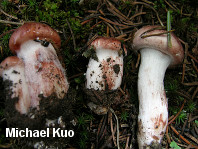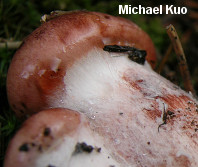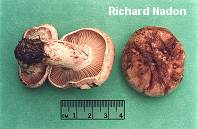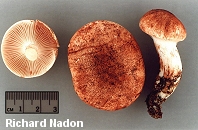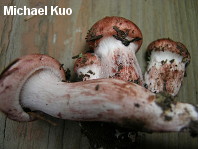Hygrophorus purpurascens (MushroomExpert.Com) (original) (raw)
Hygrophorus purpurascens
[ Basidiomycota > Agaricales > Hygrophoraceae > Hygrophorus . . . ]
by Michael Kuo
Like its cousins, Hygrophorus russula and Hygrophorus erubescens, Hygrophorus purpurascens often has the stature of a russula (despite being a waxy cap), and features surfaces that spot and discolor pink to red. However, these mushrooms lacks the crumbly, brittle flesh of russulas, and have thicker, waxy gills. The cobwebby, cortina-like partial veil of Hygrophorus purpurascens, best seen when mushrooms are in the button stage, separates it easily from its cousins.
Hygrophorus purpurascens is a conifer associate, found in montane and northern North America. Unlike several other pinkish- to purplish-red conifer-loving species of Hygrophorus, it does not develop yellow colorations or stains on its surfaces or flesh.
Description:
Ecology: Mycorrhizal with conifers; growing alone, scattered, or gregariously; late summer and fall (over winter in warmer climates); fairly widely distributed in northern and western North America, and reported from the Appalachian Mountains. The illustrated and described collections are from Colorado and Québec.
Cap: 2.5-8 cm; convex when young, becoming broadly convex or more or less flat; sticky when fresh or wet; with a streaked appearance from stretched-out, pinkish purple, appressed fibers; pinkish red to purplish red, but lighter toward the margin; the margin inrolled when young.
Gills: Attached to the stem or beginning to run down it; close or nearly distant; white when young, becoming somewhat pinkish and developing purplish or reddish spots and discolorations; waxy; when young covered by a whitish, hairy or tissuelike partial veil.
Stem: 3-7 cm long; 1-2 cm thick; equal, or with a tapering base; dry; frequently with a fragile purplish ring or ring zone, but also frequently without evidence of the veil when mature; colored like the cap or a little paler; not discoloring yellowish.
Flesh: White; unchanging; firm.
Odor and Taste: Odor not distinctive; taste not distinctive, or slightly bitter.
Chemical Reactions: KOH on cap surface erasing purple shades, becoming grayish to yellowish gray.
Spore Print: White.
Microscopic Features: Spores 5.5-8 x 3-4.5 µ; smooth; ellipsoid; hyaline in KOH; inamyloid. Hymenial cystidia absent. Lamellar trama divergent. Pileipellis an ixocutis.
REFERENCES: (Albertini & Schweinitz, 1805) Fries, 1838. (Fries, 1821; Saccardo, 1887; Hesler & Smith, 1963; Bird & Grund, 1979; Smith, Smith & Weber, 1979; Largent, 1985; Arora, 1986; Bessette, Miller, Bessette & Miller, 1995; Roody, 2003; McNeil, 2006; Lodge et al., 2013.) Herb. Kuo 08060504.
This website contains no information about the edibility or toxicity of mushrooms.
© MushroomExpert.Com
